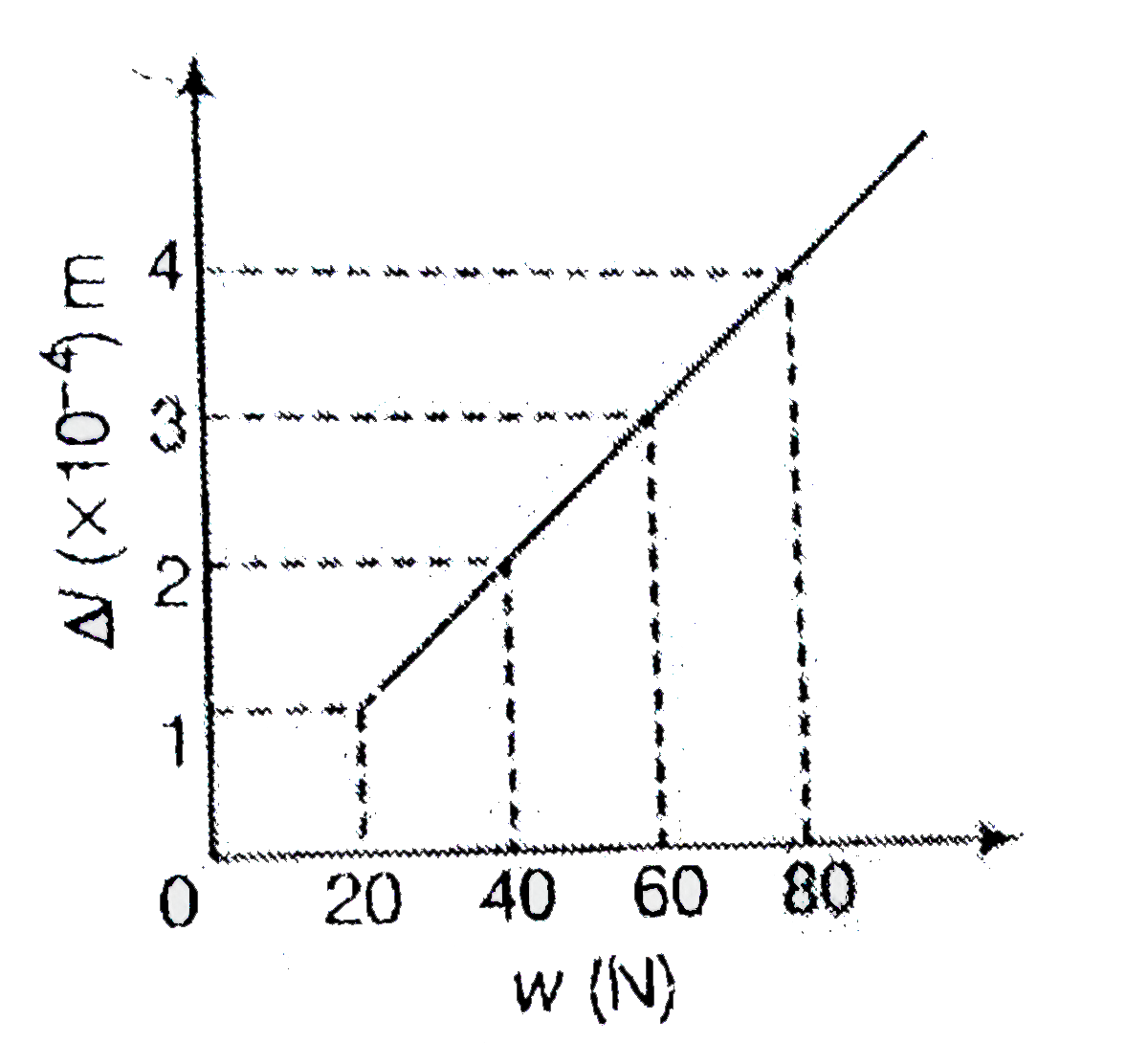A copper wire of negligible mass, 1m length and cross-sectional area 10−6m2 is kept on a smooth horizontal table with one end fixed. A ball of mass 1kg is attached to the other end. The wire and the ball are rotating with an angular velocity of 20rad/s. If the elongation in the wire is 10−3m.
a. Find the Young's modulus of the wire (in terms of ×1011N/m2).
b. If for the same wire as stated above, the angular velocity is increased to 100rad/s and the wire breaks down, find the breaking stress (in terms of ×1010N/m2).
The correct Answer is:1
To solve the problem step by step, we will address both parts (a) and (b) of the question.
Part (a): Finding Young's Modulus
1. Identify the given values:
- Length of the wire, L=1m
- Cross-sectional area, A=10−6m2
- Mass of the ball, m=1kg
- Angular velocity, ω=20rad/s
- Elongation in the wire, ΔL=10−3m
2. Calculate the centrifugal force acting on the ball:
The centrifugal force F acting on the ball when it is rotating is given by:
F=mω2L
Substituting the values:
F=1×(20)2×1=400N
3. Use the formula for Young's modulus:
The formula for Young's modulus Y is:
Y=FLΔLA
Substituting the values we have:
Y=400×110−3×10−6=40010−9=400×109N/m2
4. Convert to the required format:
We need to express this in terms of xx×1011:
Y=4×1011N/m2
Answer for Part (a):
The Young's modulus of the wire is 4×1011N/m2.
---
Part (b): Finding the Breaking Stress
1. Identify the new angular velocity:
- New angular velocity, ω=100rad/s
2. Calculate the new centrifugal force at breaking point:
Using the same formula for force:
F=mω2L
Substituting the new values:
F=1×(100)2×1=10000N
3. Calculate the breaking stress:
The breaking stress σ is given by:
σ=FA
Substituting the values:
σ=1000010−6=1010N/m2
Answer for Part (b):
The breaking stress of the wire is 1×1010N/m2.
---
- Length of the wire, L=1m
- Cross-sectional area, A=10−6m2
- Mass of the ball, m=1kg
- Angular velocity, ω=20rad/s
- Elongation in the wire, ΔL=10−3m
The centrifugal force F acting on the ball when it is rotating is given by:
F=mω2L
Substituting the values:
F=1×(20)2×1=400N
The formula for Young's modulus Y is:
Y=FLΔLA
Substituting the values we have:
Y=400×110−3×10−6=40010−9=400×109N/m2
We need to express this in terms of xx×1011:
Y=4×1011N/m2
The Young's modulus of the wire is 4×1011N/m2.
- New angular velocity, ω=100rad/s
Using the same formula for force:
F=mω2L
Substituting the new values:
F=1×(100)2×1=10000N
The breaking stress σ is given by:
σ=FA
Substituting the values:
σ=1000010−6=1010N/m2
The breaking stress of the wire is 1×1010N/m2.
Topper's Solved these Questions
- PROPERTIES OF SOLIDS AND FLUIDSBOOK - CENGAGE PHYSICS ENGLISHCHAPTER - PROPERTIES OF SOLIDS AND FLUIDSEXERCISE - Single Correct
112 Videos
- PROPERTIES OF SOLIDS AND FLUIDSBOOK - CENGAGE PHYSICS ENGLISHCHAPTER - PROPERTIES OF SOLIDS AND FLUIDSEXERCISE - Multiple Correct
17 Videos
- PROPERTIES OF SOLIDS AND FLUIDSBOOK - CENGAGE PHYSICS ENGLISHCHAPTER - PROPERTIES OF SOLIDS AND FLUIDSEXERCISE - Exercise 5.3
9 Videos
- NEWTON'S LAWS OF MOTION 2BOOK - CENGAGE PHYSICS ENGLISHCHAPTER - NEWTON'S LAWS OF MOTION 2EXERCISE - Integer type
1 Videos
- RIGID BODY DYNAMICS 1BOOK - CENGAGE PHYSICS ENGLISHCHAPTER - RIGID BODY DYNAMICS 1EXERCISE - Integer
11 Videos
Similar Questions
A copper wire of negligible mass, length l and corss-section A is kept on a smooth horizontal table with one end fixed. A ball of mass m is attached to the other end. The wire and the ball are rotating with an angular velocity ω. If elongation in the wire is Δl, obtain the expression for the Young's modulus.
mL2ωAΔL
mω2L2AΔL
mω2LAΔL
mωLAΔL
View SolutionYoung.s modulus of a wire is 2×1011N/m2. If a stress of 2 x 108 N/m2 is applied at the free end of a wire, find the strain in the wire.
View Solution
Knowledge Check
The area of a cross-section of steel wire is 0.1cm−2 and Young's modulus of steel is 2x1011Nm−2. The force required to stretch by 0.1% of its length is
A1000 NB2000 NCÂ 4000 ND5000NA wire of length L and area of cross-section A, is stretched by a load. The elongation produced in the wire is I. If Y is the Young's modulus of the material of the wire, then the force constant of the wire is
AYLABYlACYALDYAl
A body of mass M is attached to the lower end of a metal wire, whose upper end is fixed . The elongation of the wire is l.
View SolutionCalculate the force required to incrase the length of wire of cross-sectional area 10−6m2 by 50% if the Young's modulus of the material of the wire is 90×109Pa.
View SolutionA steel wire of 1.5 m long and of radius 1 mm is attached with a load 3 kg at one end the other end of the wire is fixed it is whirled in a vertical circle with a frequency 2 Hz. Find the elongation of the wire when the weight is at the lowest position Y=2×1011N/m2 and (g=10m/s2)
View SolutionA force F doubles the length of wire of cross-section a The Young modulus of wire is
View Solution_E01_080_Q01.png)
A copper wire of length 3 m and area of cross-section 1mm2 passes through an arrangement of two friction-less pulleys P1 and P2. One end of the wire is rigidly clamped and a mass of 1 kg is hanged from the other end if the young's modulus for copper is 10×1010N/m2 , then the elongation in the wire is
View SolutionThe adjacent graph shows the extension Δl of a wire of length 1m, suspended from the f top of a roof at one end and with a loaf w connected to the other end. If the cross-sectional area of the wire is 106m2 calculate the young's modulus of the material of the wire .

View Solution
